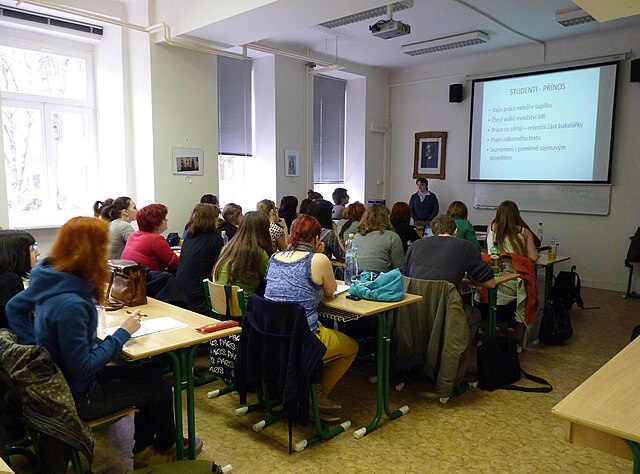Wikipedia has always been dependent on its contributors: highly motivated people with a specific sort of knowledge that they want to share with the readers. Wikipedia never has enough contributors; the more there are, the better Wikipedia gets. We, together with all the people from the Wikipedia Education Program, think that students are one particularly interesting group of potential Wikipedians. The Czech Ambassador Program is just one of many efforts worldwide that aim to grow Wikipedia’s use as a university teaching tool.
All started for the Czech Republic in spring of 2011 when an ambitious program was establishing itself on universities across the United States. We decided we wanted to try a similar thing in the Czech environment. The crucial steps in organizing it were: summoning as many team members as possible (still less then 10, rather about 5 active people), distributing work among them, and creating a communication channel both among them (i.e., an email list) and with the wider community and general public (a Wikipedia homepage, Facebook, Google+ and Twitter fan page).
The first success story came in the winter term 2011–12 with Ambassador activities at the Institute of Environmental Studies, Charles University, in Prague. This has been coordinated by the WikiProject Protected Areas and readers of this blog probably remember how elaborate the cooperation was, putting stress on personal contact with students and high quality of articles.
Sadly, we do not have enough “human resources” to expand this way of working with students, so we decided to go for a different approach in most of our projects. We usually meet the students just once or twice, giving them a short lecture about what Wikipedia is and how one can create an article. Then, we provide the students with links to help pages both on Wikipedia and also on social sites. Also, they can always e-mail to their Ambassador and ask about the things they do not understand. In the future, we would like to put stress on an interactive e-learning program that is being developed by Derek Coetzee.
In the winter term, our students created a total sum of about 100 articles, a majority (57) of them written from the field of baroque sculpture art and baroque architecture, thanks to a project at Faculty of Arts, Palacky University in Olomouc. Ten more were concentrating on highly specific topics in immunology (a project at Faculty of Science, Charles University) and the last ~30 are the above-mentioned Institute of Environmental Studies.
Right now, a summer term is on the way, bearing a promise of 150–200 articles in total. Crucially, we work in three major cities of the Czech Republic (Prague, Olomouc, Brno) and as we try to involve the local community, ambassadorship has proven to be a promising way of outreach from the capital and engaging people from the other parts of the country. Our projects now range from Physical Chemistry and basic Algebra to Scandinavian Literature, Iconography, Histology/Cytology and Botany. See the recent changes from all our current projects.
A great example of our projects is “Histology/Cytology”, carried out at the Faculty of Science, Charles University, and taught by doc. RNDr. Jan Černý, Ph.D. This subject attracts more than 100 students every year. We did not want to make it a tedious duty for students, so we told them: write on Wikipedia only if you like, and if you do your job well, we will give you 5 points extra to the final exam. What followed was an explosion: a lot of students starting asking us about the project, so we were really motivated to prepare the guidelines for the students. We also made two public lectures in Brmlab (a local do-it-yourself scientific club) on how Wikipedia works. The best thing was that some students really began writing article after article, becoming real experienced and well-oriented Wikipedians. The thing that I like the most is that six out of seven students who have filled in a questionnaire so far wrote that they wanted to continue editing Wikipedia after the assignment ends for them. All in all, the Czech Wikipedia is richer by more than seventy articles on Histology and Cell Biology — and this number keeps growing.
Vojtěch Dostál, Wikimedia Czech Republic

Can you help us translate this article?
In order for this article to reach as many people as possible we would like your help. Can you translate this article to get the message out?
Start translation

